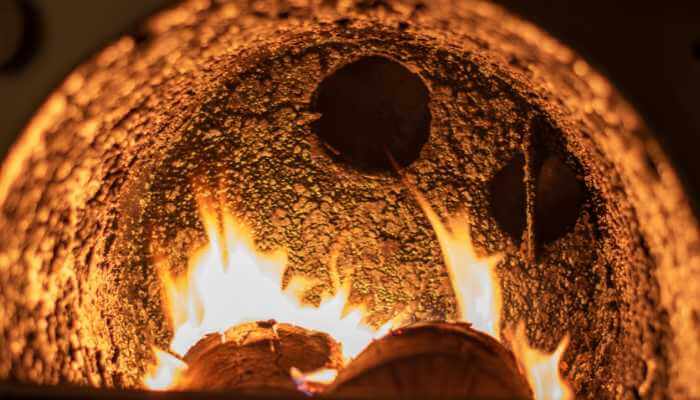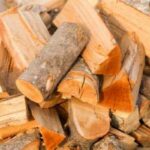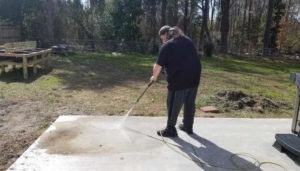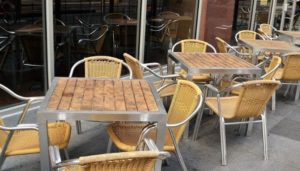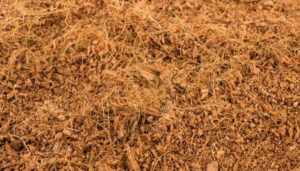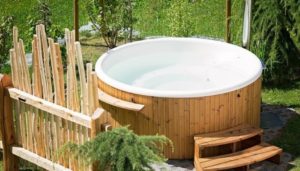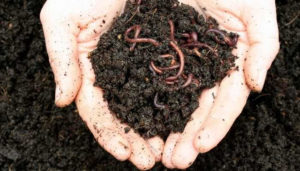If you’re new to using firewood, it’s easy to get confused about what creosote is, how it has been used, or how to get rid of it.
Creosote logs are not made with creosote but are made to get rid of it. They are chimney-cleaning logs that can be burned with any fire. They release chemicals that make the build-up of creosote in your chimney and flue flake off for easier removal. You can use them between professional cleanings.
There are things you need to understand about their use and why they are used. It also leads me to some critical information about the use of creosote-treated wood in landscaping that might be important to you. So please read on…
What Is Creosote, and How Is It Made?
Creosote is a dark liquid that forms when organic materials burn. This can be wood burning, coal burning, and even oil burning can create chemicals similar to creosote.
Creosote is produced by the incomplete combustion of organic matter, like wood. When fuel burns completely (for example, when coal burns), its carbon bonds are broken down into carbon dioxide gas—which is harmless at average concentrations. But when fuel burns incompletely (for example, when wood burns), some of its carbon bonds are broken down into toxic carbon monoxide and explosive hydrogen gases—that’s where creosote comes from!
This makes creosote very dangerous, especially when it builds up in a chimney, for instance. This can happen when you need more airflow in your chimney. It can also occur when the wood is burned in a fireplace, especially green or damp wood. The smoke condenses on the way up the flue. It sticks to the inside of the chimney instead of making it all the way out.
Now, if there are only the thin, flakey deposits in there, this is easy to clean out. The deposits can even come loose easier once you’ve burned one of these creosote cleaning logs. A brush can be used, and a lot of it can be removed without the need for professionals until later.
However, suppose the creosote deposits are beginning to look like tar with some flakes. In that case, it can be a lot more challenging to remove. Burning a creosote cleaning log and a bit of cleaning might buy you some time. Still, you should really look into a professional chimney sweep. And if the build-up is so bad, it looks like a tar glaze, do not wait to get your chimney professionally cleaned. This is when things get dangerous.
I’ve experienced a chimney fire before, and it was frightening. We were lucky that a neighbor saw the fire, which was put out before it spread to the roof. Had my parents known about creosote, they wouldn’t have let the build-up become dangerous. That’s why having your chimney cleaned now and again is an excellent idea.
What Are Creosote Logs?
Chimney sweeping is cleaning out your chimney to keep it safe for use. In other words, getting rid of the dangerous build-up of creosote and ash in your chimney. To help with that process, you may want to use a creosote log. Other names for a creosote log are a chimney-sweeping log, a creosote-cleaning log, and a chimney-cleaning log.
When burned and taken up and over the creosote build-up in your flue, the chemicals in this log can cause it to flake and detach. But that’s only if the creosote has yet to get to the tar and glazed tar stage. Once the creosote begins looking like tar and worse, professional help is required to keep your chimney safe. A creosote log won’t help.
However, if you know the chimney is clear and you’re having trouble finding good firewood in your area or have a lot of rainy days during your burn season, then creosote cleaning logs might be worth looking into. You could keep them around for a monthly burn to keep the creosote from building up too quickly.
What Is Creosote Used For?
You know how it was made and the basics, so what is creosote generally used for? Creosote is made up of anti-microbial compounds, including phenol and cresol. Because of this, creosote can kill bacteria and fungi that would otherwise cause decay in wood products. It has been used to preserve wood and protect it from rot and has been used for this purpose since the 1800s.
But mold, mildew, and rot aren’t the only pests that creosote could protect the wood from. Pesticide products containing creosote as the active ingredient were sprayed on wood (such as railroad ties and utility poles) to protect them against termites, fungi, mites, and other pests
Since It’s a Good Insect and Rot Repellent, Should You Use Wood Coated in Creosote in Your Landscaping?
The EPA currently restricts the use of creosote to commercial use only. It is used to treat power poles and crossties used for train tracks. Why is it limited to those uses?
Creosote is a possible human carcinogen. According to the EPA, it has no registered residential use. So it’s actually illegal to use old railroad ties in a home landscape. Want more proof?
“Creosote is not approved to treat wood for residential use, including landscaping timbers and garden borders. There are no approved residential uses of creosote-treated wood. The Agency is aware that creosote-treated railroad ties are being used in the residential setting for landscape purposes and as a border around gardens. Such uses in residential settings are not intended uses of creosote. If you have creosote-treated wood in your yard, consult the handling precautions outlined in this document.”
Residential use of creosote is banned, including its use in landscaping and gardening. This is especially true for wood that may come into contact with food, feed, or drinking water. And before you ask, I know! I’ve seen these things everywhere, including as a structure for raised garden beds. They are even still being sold to residential customers.
Why are railroad crossties available for sale if they are supposedly bad for you and the environment?
It seems that the EPA called the use of creosote in landscaping “not approved” but has not made it illegal for people to sell or buy railroad crossties for that purpose.
I checked with some of the big box stores online and to say I’m shocked is an understatement.
It is not approved for internal usage, and it is not approved for any usage near food or water sources. It is not approved for residential use. This is because of the toxicity in the creosote. So if you were going to use railroad crossties for your raised garden bed, please think twice. If you buy a property that uses railroad ties in a gardening structure, consider removing them and replacing them.
I hope this was as informative to you as it was for me. I did not know a lot of this information, and I will definitely now be able to use it going forward. If you have any questions, please feel free to contact us!
